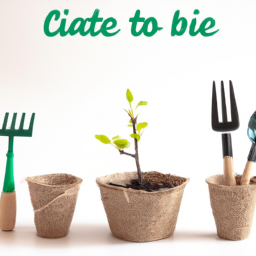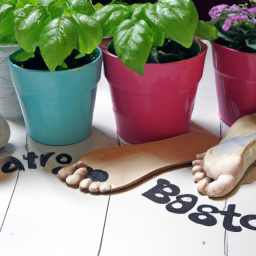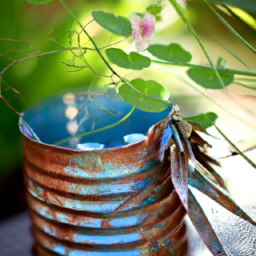
Do you ever find yourself looking at your garden and feeling like it could use a little something extra? Well, we have the perfect solution for you: upcycled garden art! Upcycled garden art is all about taking discarded or unused materials and transforming them into beautiful, one-of-a-kind pieces that will add a unique touch to your outdoor space. In this blog post, we will explore the world of upcycled garden art and show you how you can create beauty from recycled materials. So, grab a cup of tea and get ready to be inspired by the endless possibilities of upcycling in your garden!
Benefits of Upcycled Garden Art: Exploring the Environmental and Aesthetic Advantages
When it comes to creating a beautiful and sustainable garden, upcycled garden art is an excellent choice. Not only does it allow you to express your creativity, but it also helps reduce waste and contribute to a healthier environment. In this article, we will explore the environmental and aesthetic advantages of upcycled garden art and provide you with a step-by-step guide on how to create your own unique pieces.
Environmental Advantages
One of the primary benefits of upcycled garden art is its positive impact on the environment. By repurposing discarded materials, you are diverting them from landfills and reducing the need for new resources. This practice helps conserve energy and reduces pollution associated with the production and transportation of new materials.
Upcycled garden art also promotes sustainability by extending the lifespan of objects that would otherwise be thrown away. By giving new life to old items, you are reducing the demand for new products, which in turn reduces the strain on natural resources. This approach aligns with the principles of the circular economy, where materials are kept in use for as long as possible.
Additionally, upcycled garden art encourages a mindset of resourcefulness and creativity. It challenges us to see the potential in everyday objects that might otherwise be overlooked or discarded. This shift in perspective can inspire us to adopt more sustainable practices in other areas of our lives as well.
Aesthetic Advantages
Aside from the environmental benefits, upcycled garden art also adds a unique and charming aesthetic to your outdoor space. By incorporating recycled materials into your garden, you can create one-of-a-kind pieces that reflect your personal style and story.
Upcycled garden art allows you to experiment with different textures, colors, and shapes that are not typically found in traditional garden decor. From whimsical sculptures made from old metal tools to colorful flower pots crafted from repurposed containers, the possibilities are endless. These unconventional elements can inject character and visual interest into your garden, making it a truly captivating and memorable space.
Furthermore, upcycled garden art often sparks conversations and serves as a conversation starter. Visitors to your garden will be intrigued by the unique pieces and may inquire about their origin or the story behind them. This provides an opportunity to share your passion for sustainability and inspire others to consider upcycling in their own lives.
Step-by-Step Guide to Creating Upcycled Garden Art
Now that we have explored the benefits of upcycled garden art, let’s dive into a step-by-step guide on how to create your own unique pieces:
1. Collect Materials: Start by gathering a variety of discarded materials such as old metal objects, wooden pallets, glass bottles, or even broken ceramics. Look for items with interesting shapes, textures, or colors that can be transformed into garden art.
2. Plan Your Design: Once you have your materials, brainstorm different design ideas for your garden art. Consider the theme or style you want to achieve and how the materials can be repurposed to fit that vision. Sketch out your design or create a mood board for inspiration.
3. Prepare and Assemble: Clean and prepare the materials for upcycling. Remove any rust, dirt, or sharp edges that may pose a safety hazard. Assemble the pieces using appropriate tools and techniques, such as welding or glue, depending on the materials involved.
4. Enhance and Protect: Once your garden art is assembled, consider adding finishing touches such as paint, varnish, or sealant to enhance its appearance and protect it from outdoor elements. Choose eco-friendly options whenever possible to maintain the sustainability aspect of your creation.
5. Display and Enjoy: Finally, find the perfect spot in your garden to showcase your upcycled masterpiece. Consider the surrounding plants and landscaping to create a harmonious and visually appealing arrangement. Step back, admire your work, and enjoy the unique beauty you have brought to your outdoor space.
Remember, upcycled garden art is all about embracing creativity and sustainability. Let your imagination run wild, experiment with different materials, and have fun while making a positive impact on the environment. Your garden will become a testament to the beauty that can be created from recycled materials.

h2 {
font-size: 24px;
font-weight: bold;
margin-bottom: 10px;
}
h3 {
font-size: 20px;
font-weight: bold;
margin-bottom: 5px;
}
p {
font-size: 18px;
line-height: 1.5;
margin-bottom: 10px;
}
body {
max-width: 800px;
margin: 0 auto;
padding: 20px;
}
DIY Upcycled Garden Art Projects: Transforming Waste into Unique Outdoor Decor
Gardens are not only a place to grow plants but also an opportunity to express creativity and add beauty to your outdoor space. Upcycled garden art is a fantastic way to repurpose waste materials and transform them into unique and eye-catching decorations for your garden. In this guide, we will explore various DIY upcycled garden art projects that will inspire you to create stunning outdoor decor while reducing waste.
1. Recycled Bottle Planters
Plastic bottles are one of the most commonly discarded items, but they can be easily upcycled into charming planters for your garden. Start by collecting empty plastic bottles of different sizes and shapes. Cut off the top part of the bottle, leaving the bottom as the planter. Make drainage holes at the bottom and fill the bottle with potting soil. You can then plant flowers, herbs, or small shrubs in these bottle planters and arrange them creatively in your garden.
For a more artistic touch, you can paint the bottles with vibrant colors or even create patterns using acrylic paint. Hang the bottles from tree branches or arrange them on a trellis for a visually appealing display. Recycled bottle planters not only add a unique touch to your garden but also promote sustainability by reusing plastic waste.
Another creative idea is to make vertical gardens using plastic bottles. Cut the bottles in half and attach them to a wooden frame or fence using zip ties. Fill each bottle half with soil and plant your favorite herbs or flowers. This vertical garden not only saves space but also adds a green and colorful element to your outdoor area.
2. Tire Planters
Old tires are often discarded and end up in landfills, but they can be easily transformed into stylish planters for your garden. Start by cleaning the tires thoroughly and removing any dirt or debris. You can paint the tires with weather-resistant paint in vibrant colors to add a pop of color to your garden.
To create a tire planter, place the tire on the ground and fill it with potting soil. Plant flowers, succulents, or even small trees in the tire. You can stack multiple tires on top of each other to create a unique vertical planter. Arrange the tire planters in different areas of your garden or hang them from tree branches for a visually appealing display.
If you want to take your tire planter to the next level, you can create a tire swing planter. Hang the tire horizontally from a sturdy tree branch using strong ropes. Fill the center of the tire with soil and plant flowers or trailing vines. This unique hanging planter will not only add beauty to your garden but also provide a cozy spot for birds and butterflies.
3. Upcycled Metal Sculptures
Old metal objects such as rusted tools, bicycle parts, or discarded kitchenware can be transformed into stunning sculptures for your garden. Start by collecting various metal items with interesting shapes and textures. Clean the metal objects and remove any rust or dirt.
With a little creativity, you can assemble these metal objects into unique sculptures. Weld or glue the pieces together to create a stable structure. You can create sculptures of animals, flowers, or abstract designs depending on your preference. Once the sculpture is complete, you can paint it with weather-resistant paint to protect it from rust and add a touch of color.
Place the metal sculptures strategically in your garden to create focal points and add visual interest. They can be placed among plants, near water features, or even mounted on walls or fences. These upcycled metal sculptures not only add a touch of artistry to your garden but also serve as a reminder of the importance of recycling and repurposing.
By engaging in DIY upcycled garden art projects, you can unleash your creativity while contributing to a more sustainable environment. These projects not only transform waste materials into unique outdoor decor but also serve as a conversation starter and inspiration for others to embrace upcycling. So, gather your materials, put on your creative hat, and start creating stunning upcycled garden art that will truly make your outdoor space shine!
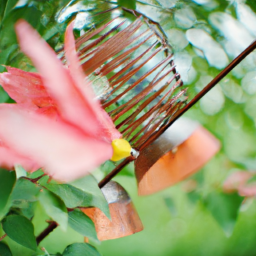
3. Tips for Creating Upcycled Garden Art: Inspiration and Techniques for Making Beautiful Pieces from Recycled Materials
Are you looking to add a unique touch to your garden while also reducing waste? Upcycled garden art is the perfect solution! By repurposing old or discarded materials, you can create beautiful and eco-friendly pieces that will enhance the beauty of your outdoor space. In this article, we will provide you with some tips and techniques to inspire your creativity and get you started on your upcycled garden art journey.
Finding Inspiration
Before you begin creating upcycled garden art, it’s important to find inspiration. Look around your garden and observe the existing elements. Are there any areas that could benefit from a focal point or a decorative piece? Consider the theme or style you want to achieve – rustic, whimsical, modern, or something entirely unique. Once you have a clear vision in mind, you can start gathering materials that align with your desired aesthetic.
One great source of inspiration is nature itself. Take a walk in the woods or visit a local park to collect fallen branches, stones, or shells. These natural materials can be incorporated into your garden art to add an organic and earthy feel. You can also find inspiration in everyday objects that would otherwise be thrown away. Old bicycle wheels, broken ceramic plates, or even discarded metal scraps can be transformed into stunning garden sculptures.
Another way to find inspiration is by exploring online platforms and social media. Websites like Pinterest and Instagram are treasure troves of upcycled garden art ideas. Browse through various projects, save your favorite images, and adapt them to suit your own style. Remember, the key is to let your imagination run wild and think outside the box!
Techniques for Creating Upcycled Garden Art
Once you have gathered your materials and found inspiration, it’s time to get creative and start making your upcycled garden art. Here are some techniques to help you bring your ideas to life:
1. Assemblage: Assemblage is the art of combining different materials to create a cohesive piece. Start by selecting a base or framework for your artwork, such as an old wooden pallet or a metal frame. Then, attach your chosen materials using screws, nails, or strong adhesive. For example, you could attach colorful glass bottles to a metal frame to create a unique vertical garden or repurpose old window frames to make a decorative garden screen.
2. Mosaic: Mosaic is a technique that involves arranging small pieces of colored glass, ceramic, or other materials to create patterns or images. To create a mosaic garden art piece, start by selecting a sturdy surface like a wooden board or a concrete slab. Break or cut your chosen materials into small pieces and arrange them in a design of your choice. Secure the pieces with adhesive and grout the gaps. You can create mosaic stepping stones, tabletops, or even mosaic-covered sculptures.
3. Sculpture: Sculpture allows you to transform ordinary objects into three-dimensional artworks. Look for materials with interesting shapes or textures, such as driftwood, old tools, or discarded metal objects. Combine these materials using welding, wire wrapping, or other techniques to create unique sculptures. For example, you could weld together old garden tools to form a whimsical flower sculpture or use wire to create intricate bird sculptures.
Remember, the possibilities are endless when it comes to upcycled garden art. Don’t be afraid to experiment, mix and match materials, and let your creativity shine. By repurposing materials that would otherwise end up in a landfill, you are not only creating beautiful pieces for your garden but also contributing to a more sustainable future.
Here are the Essential Points
Are you looking for a creative way to add some personality to your garden? Look no further than upcycled garden art! This trend has been gaining popularity among eco-conscious gardeners who want to reduce waste and create unique, eye-catching pieces for their outdoor spaces. Upcycling involves repurposing old or discarded items and transforming them into something new and beautiful, giving them a new lease on life.
The possibilities for upcycled garden art are endless. You can turn old tires into colorful planters, transform wine bottles into stunning wind chimes, or repurpose broken ceramics into mosaic stepping stones. Not only does upcycled garden art add a touch of whimsy and charm to your garden, but it also helps reduce landfill waste and promotes sustainable living. So, instead of throwing away those old items, why not get creative and turn them into something beautiful for your garden? With a little imagination and some basic DIY skills, you can create unique, eco-friendly art that will make your garden truly stand out.
Let me leave you with some FAQs:
Q1: What is upcycled garden art?
A1: Upcycled garden art refers to the creative process of repurposing discarded or recycled materials to create unique and beautiful decorative pieces for your garden. It involves giving new life to old items that would otherwise end up in the landfill.
Q2: What materials can be used for upcycled garden art?
A2: You can use a wide range of materials for upcycled garden art, including but not limited to old tires, broken ceramics, wine bottles, tin cans, wooden pallets, discarded metal objects, and even old furniture. The possibilities are endless, and you can let your imagination run wild!
Q3: How can I get started with upcycled garden art?
A3: To get started with upcycled garden art, you can begin by collecting materials that you think can be repurposed. Look for items in your home, garage, or local thrift stores that have potential for transformation. Once you have your materials, brainstorm ideas and sketch out designs for your garden art. Then, gather the necessary tools and get to work bringing your creations to life.
Q4: What are some popular upcycled garden art ideas?
A4: There are countless popular upcycled garden art ideas to choose from. Some examples include creating flower planters out of old boots or teapots, turning wine bottles into wind chimes, making garden sculptures from scrap metal, or repurposing wooden pallets into vertical gardens. You can also personalize your creations by adding paint, mosaic tiles, or other decorative elements.
Q5: What are the benefits of upcycled garden art?
A5: Upcycled garden art offers several benefits. Firstly, it helps reduce waste by giving new life to discarded materials. Secondly, it allows you to express your creativity and create unique, one-of-a-kind pieces for your garden. Additionally, it can be a cost-effective way to decorate your outdoor space since you’re repurposing items you already have or can find inexpensively. Lastly, upcycled garden art adds a touch of eco-friendliness and sustainability to your garden, showcasing your commitment to the environment.
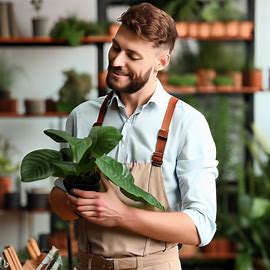
Alex Turner is a sustainable gardening advocate and the founder of an acclaimed indoor gardening blog. With a focus on eco-friendly practices and urban sustainability, Alex combines his background in environmental studies with his love for plants to educate readers on mindful indoor gardening. His work highlights the importance of nurturing both plants and the planet.

